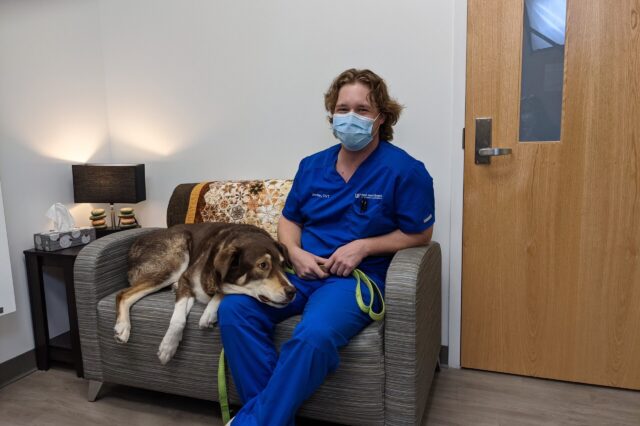Oral health affects all aspects of pet wellness, UF veterinarians say

Pets use their mouths in much the same way humans use their hands̰ — to explore the world. University of Florida veterinarians say a great way to start the new year off right is by ensuring that your animals have the healthiest mouths possible.
Routine dental care may not come to mind as a reason to regularly visit the veterinarian, but it is an area of pet health that UF veterinarians say needs as much attention as other preventive means of fighting disease, such as vaccines and medications.
“Oral health affects all other systems in the body,” said Amy Stone, D.V.M., Ph.D., chief of the UF Small Animal Hospital’s primary care and dentistry service. “It’s a key component of overall pet health and wellness.”
Oral health is becoming a greater focus among veterinarians and instructors.
“The veterinary profession has really started to understand how dental health effects our patients,” Stone said. “We are teaching more of it to our students and are here to help local veterinarians with anything we can. We do some advanced dentistry procedures here at UF and we have an anesthesia team available to assist when we need to treat animals with more complicated conditions.”
Dental disease begins early in life. By the age of 3, most dogs and cats have some degree of dental disease, according to the American Animal Hospital Association. Early signs of dental disease in pets include bad breath, yellow tartar buildup on the teeth and red, swollen gums. Not always apparent to pet owners, periodontal disease can cause oral pain, infection, inflammation and other health problems, decreasing the quality of life for these pets.
“Animals don’t show owners that they are in pain,” Stone said. “They still eat to survive. If an animal’s mouth is healthier and less painful, they might want to move more, eat more nutritious food and be more interactive.”
In addition to being hazardous for other reasons — such as their potential to cause gastrointestinal upset — certain chew toys and other foreign objects could be too hard for your pet to safely chew on, causing broken teeth.
Speaking of what pets put in their mouths, excessive food consumption can lead to obesity, another significant threat to pet health. In fact, in addition to oral disease, obesity is the second most common condition that Stone and her team see in their patients, with one in three pets being overweight.
“We all know that when we weigh too much and our bodies hurt, we are not our best selves,” she said. “Pets that are obese don’t feel great and their entire interaction with the world is painful.”
Stone and her team work hard to educate their clients about not just the importance of good pet nutrition and a healthy diet, but also the relationship of diet to oral health.
One of their patients, Ruger, an 11-year-old malamute-lab mix, is owned by UF small animal veterinary technician Jordan Harriz. He and his wife adopted Ruger in 2016 and he immediately became part of their family.
“He has maintained his status as the family couch potato and designated cuddler,” Harriz said.
When Ruger last visited his previous veterinarian in February, he was given a clean bill of health despite being slightly overweight and having mild dental tartar, Harriz said. But soon after, Harriz noticed Ruger was starting to slow down, becoming less playful and less excited about the things he used to enjoy.
“He also started becoming head shy and dropping food,” Harriz said. “Foolishly, I thought that these were just signs of him getting older, and I didn’t think anything of it.”
When he began working at UF, Harriz initially received training in the Primary Care and Dentistry Service and had the opportunity to work on applicable continuing education credits offered by AAHA — including dentistry standards.
“The videos I watched mentioned head shyness, food dropping, bad breath and loss of energy as issues associated with dental disease,” Harriz said. “I had noted all of these behaviors in Ruger and decided to take a closer look myself. What I found was massive tartar build-up, lesions on his gums and some serious dental disease.”
Harriz scheduled a visit with Stone.
“Her diagnosis mirrored my own findings: severe dental disease with likely abscessing and dire need of a dental cleaning with extractions,” Harriz said. “She also noted during his visit that he was about 10 pounds overweight.”
Stone recommended dental surgery as soon as possible, and once performed, followed up by administering a course of antibiotics and pain medication to help reduce infection and pain. She also advised Harriz to put Ruger on a diet to get him to a healthier weight and reduce strain on his joints.
“His diet at home was as simple as reducing intake and increasing exercise,” Harriz said. “I cut down his food by just a half cup a day and made a better effort to take him, and my other two dogs, to the park more regularly.”
In the month between his initial appointment and his surgery, Ruger has lost around 5 pounds, and continues to lose weight now, Harriz said.
Talk to your veterinarian about your pet’s oral health and if you need to work together on a weight loss plan for your four-legged family member, Stone said.
“Common perceptions about these things are often skewed,” she said.
Once you’ve had that conversation with your vet and scheduled your next wellness examination, you and your four-legged friend should be able to safely, and happily, take a bite out of the new year.
Media contact: Ken Garcia at kdgarcia@ufl.edu or 352-273-9799.
About the author
